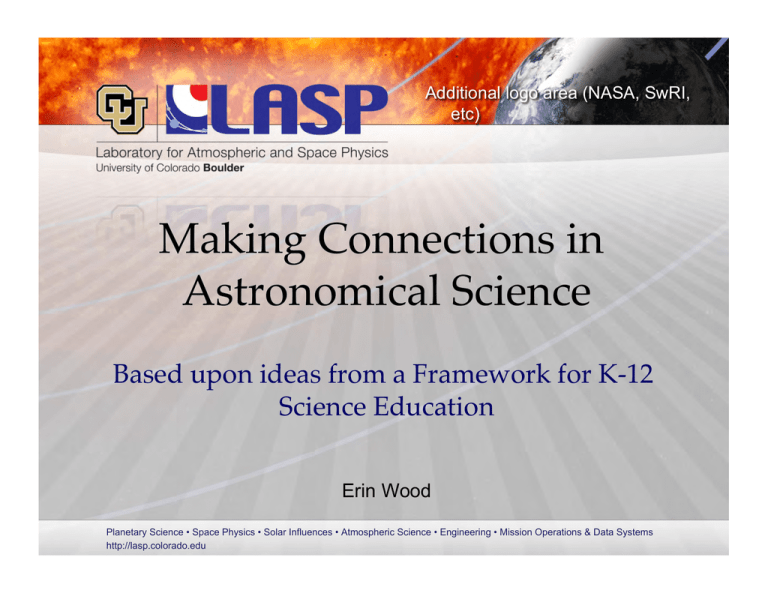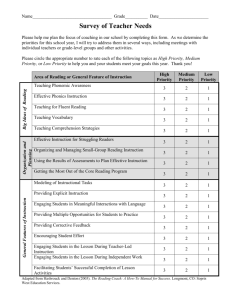Document 12624832
advertisement

Additional logo area (NASA, SwRI, etc) Making Connections in Astronomical Science Based upon ideas from a Framework for K-12 Science Education Erin Wood Planetary Science • Space Physics • Solar Influences • Atmospheric Science • Engineering • Mission Operations & Data Systems http://lasp.colorado.edu Next Generation Science Standards Science Practices • • • • Developing and using models Analyzing and interpreting data Constructing explanations Engaging in argument from evidence Do students understand the importance of models? What types of models do you use in the classroom? Analyzing and Interpreting Data: Types of real data for your class • • • • Raw Pre-processed for the class Citizen science (pre-packaged) Authentic classroom exploration Why is authentic data powerful? Resources for Classroom Friendly Data Observing with NASA Resources for Classroom Friendly Data MyNASAdata Resources for Classroom Friendly Data NASA Earth Observatory Resources for Classroom Friendly Data Pre-packaged data: Missions Pre-Packaged Data: Institutes If students engage in authentic science using real data will they… • Construct explanations? • Engage in argument using evidence? Are there differences between a student driven investigation and learning that occurs in a pre-packaged lesson? Help students construct explanations of observations/ engage in arguments using data. Start simple! • • • • • Phases of the moon Seasons Solar cycle Planetary motions Much much much more… Do your students walk in the door with pre/ misconceptions? How do you probe for this? Next Generation Science Standards: Crosscutting Concepts • Patterns • Cause and Effect: Mechanisms and Explanation • Systems and System Models Click to add image credit info No “march of the solar system” when discussing patterns Earth is one body in our solar system. Are we alone? • Weather systems • Cycles • Seasons • Geology Seeing the Bigger Picture • How the Sun affects climate • How the Sun influences wind/weather • How the planets orbit the Sun (and how that effects temperature) • How the Sun is one “middle of the road” star out of 100 billion stars in our galaxy and 100 billion galaxies • How we are one planet, potentially out of billions, orbiting other stars What patterns do you use in your current teaching practice that you could tie to astronomy? Cause and effect: Mechanisms and Explanation • Can students identify causation v. correlation? Note: Church of the Flying Spaghetti Monster’s definition of pirate designates resent pirate activity as “pseudo piracy” Click to add image credit info Can students evaluate scientific evidence? Can they think critically? Think of Examples of Media/public/conspiracy -Induced Misunderstandings…And ways to combat these misunderstandings. Think-Pair-Share • 1 minute to think • 1 minute to write • 2 minutes to discuss with a neighbor Can Students Make Sense of Data? Systems v. System models: How we observe the unobservable, predict, and explain • • • • • • Trace back through Mars history? Predict climate change? Understand the physics of the upper atmosphere? Understand Earth’s radiation belts? Model motions of a star? Predict what’s happening beneath the photosphere of the Sun? What teaching techniques do you use to explain how models support observations? And finally… It must be engaging. What are ways we can accomplish this? And finally… It must be engaging. What are ways we can accomplish this? And finally… It must be engaging. What are ways we can accomplish this? And finally… It must be engaging. What are ways we can accomplish this? And finally… It must be engaging. What are ways we can accomplish this? And finally… It must be engaging. What are ways we can accomplish this? Final thoughts?
